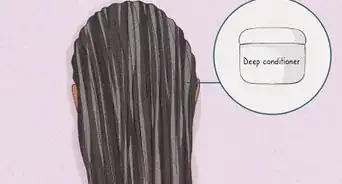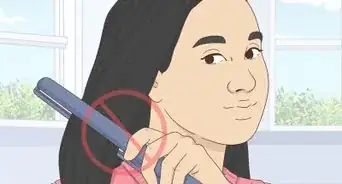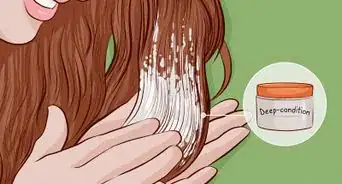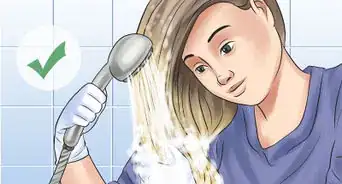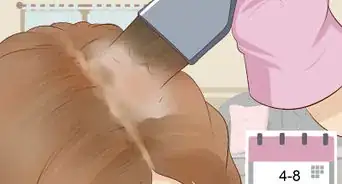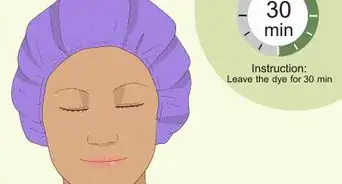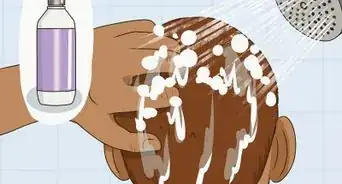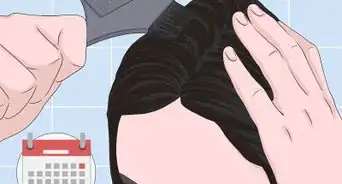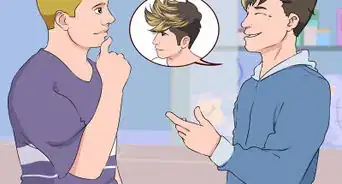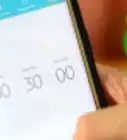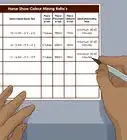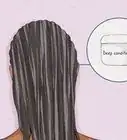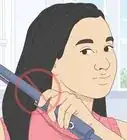This article was co-authored by Christine George. Christine George is a Master Hairstylist, Colorist, and Owner of Luxe Parlour, a premier boutique salon based in the Los Angeles, California area. Christine has over 23 years of hair styling and coloring experience. She specializes in customized haircuts, premium color services, balayage expertise, classic highlights, and color correction. She received her cosmetology degree from the Newberry School of Beauty.
There are 11 references cited in this article, which can be found at the bottom of the page.
This article has been viewed 27,755 times.
You might be worried about dyeing your hair a new color if your roots are a different shade, or maybe you just want a root touch-up that will match your hair color. Luckily, there are lots of products and hair colors that will fix any problems you might have. If you're just dyeing your roots, make sure you apply the color or bleach to your roots only for a more natural look. To dye all of your hair a new color, you may need to mix two hair dyes together to create a neutral tone for your roots, and then apply your regular chosen dye color to the rest of your hair.
Steps
Choosing a Touch-Up Technique
-
1Add a neutral pigment to your hair dye color if you have gray roots. If you’re trying to cover up gray roots before dyeing your hair, purchase a hair dye that’s an ashy tone of your desired color. Mix the ashy color together with your desired dye color, applying this mixture to your roots. The ash tone will help neutralize the gray so that you don’t end up with super vibrant roots.[1]
- For example, if you want to dye your hair red and it’s currently brown with gray roots, choose a neutral red shade that says “ash” or “cool,” mixing it with the red hair dye you’d like to use.[2]
- If you just want to touch up gray roots while keeping the same hair color, opt for one shade darker than your hair color for the roots.
- You can dye your roots in the same session that you dye the rest of your hair, just be sure to only add the ashy tone to the dye going on your roots.
-
2Bleach your roots to match your light-colored hair. Touch up your roots the same way you dyed the rest of your hair, applying the bleach carefully to just your roots. Leave the bleach in for less time than you did the rest of your hair—the heat from your roots will activate the bleach faster. Rinse the bleach out thoroughly after waiting the recommended amount of time.[3]
- Once your roots are bleached, you can apply the specific hair color to your roots that matches the rest of your hair.
- Purchase a hair-safe bleach from your local beauty or big box store, paying close attention to the directions to use it properly.
- Wear gloves and clothing you don’t mind getting ruined when bleaching your hair, even if it is just the roots.
Advertisement -
3Apply dye to your roots only to cover lighter hair growth. If you usually dye your hair a darker shade than your natural color, only brush the hair dye mixture onto your roots. If you overlap too much with your already-dyed hair, it can cause breakage or a super dark shade in the overlapped area.[4]
- Be aware that the heat from your roots will cause the chemicals to react with your hair more quickly, speeding up the processing time.
-
4Use a gloss or cool-toned dye to fix hot roots. If your roots are super brassy or creating a halo effect around your head, try applying a purple or silver gloss to your hair that deposits color to help neutralize the orange tone. If you’re using a hair dye, avoid dyes with warm undertones, and instead choose ones that are ashy or cool.[5]
- Purchase an at-home gloss that comes in a shampoo or conditioner form at your local beauty store.
- The hair dye packaging will say whether the color you’ve chosen is warm or cool.
-
5Purchase a root touch-up product for a quick fix. These include things like sprays, powders, or even pencils. Visit your local beauty or big box store to find a product that you can use quickly on-the-go, choosing a shade that matches your hair color.[6]
- Spray or rub these touch-up products onto your roots to mask the old color, or use them to touch up gray hairs.
- These products are usually used as a quick fix, not a permanent solution to your roots.
Applying the Dye
-
1Spread petroleum jelly along your hairline to prevent stains. Apply a thin layer of the jelly to your skin right along your hairline using your fingers. If you accidentally get any hair dye onto your skin, the petroleum jelly will prevent it from causing stains.[7]
- Use a wet rag or washcloth to remove the petroleum jelly after you’ve completely finished the dye or bleach process.
-
2Mix your hair dye with a 10-volume developer. Combine the hair dye and developer using a hair dye application brush to mix the two together. The common ratio is 1 part color to 2 parts developer, but read the instructions that come with your specific dye to be certain.[8]
- If you’re bleaching your hair, you’ll also use developer. Read the instructions that come with the bleach for the correct ratio of bleach to developer.
- If you're using a boxed dye, read the box to find out what kind of developer they suggest to use with the specific brand.
- Wear gloves and old clothing you don't mind getting ruined.
- You may choose to use a 20-volume developer, but this is more damaging to your hair.
-
3Separate your hair to make it easier to dye. If you’re just dyeing your roots, part your hair how you normally do to begin the process. If you’re dyeing your whole head, you might lift the top layer of hair into a clip to begin dyeing the bottom layer first. However you choose to separate your hair, make sure you know which sections you’ve already dyed by clipping them back or wrapping them in foil.[9]
- Separate sections of hair using the tip of a fine tooth comb.
- When it comes to your roots, some people choose to only touch up the roots that are visible, while others like to dye the roots on their entire head.
-
4Brush the dye onto your roots only if you’re doing a touch up. Use a hair dye application brush to apply the mixed dye to your roots. Be careful not to overlap too much with the section of your hair that isn’t the same color as your roots because this could cause different tones to show up in the overlapped section.[10]
- To refresh the color on your whole head, use a comb to brush through your hair towards the end of the dye processing time so that the dye used on your roots is distributed throughout your hair evenly.
- Use the fine tooth comb to brush back new layers of roots to color.
- This is the same process used for applying bleach to your roots.
-
5Apply the dye to your roots last if you’re dyeing your whole head. If your hair is one color and you’re dyeing it another color, brush the dye onto each section of hair starting roughly 2 in (5.1 cm) from the roots going down to the ends of your hair. Color your roots last, as your roots are affected by color the fastest.[11]
- For example, if your hair is brown but you’re dyeing it black, brush the dye onto each strand of hair starting near the middle of your head, working your way down to the ends before brushing the black dye onto your roots at the end.
- Remember to mix in an ash tone with your hair dye when doing your roots if your roots are a lighter color than the rest of your hair.
-
6Wait the recommended amount of time for the color to develop. Look at the instructions that came with your hair dye or bleach to see how long to leave the product in your hair. Usually this is roughly 25-30 minutes, depending on the intensity of the product you're using.[12]
- You may be able to watch as the color develops on your hair, helping you decide when it's time to rinse.
- Set a timer so you know exactly when to remove the dye from your hair.
-
7Rinse your hair out thoroughly with cold water. Once the dye has set, stand in the shower and rinse the dye out of your hair thoroughly. If you only dyed your roots, massage the top of your head to help make sure you're rinsing thoroughly. Use cold water to help lock in the color.[13]
- You can shampoo your hair too, just be aware that some of the color may come out.
- Wear gloves during this process to keep your hands from getting stained.
Expert Q&A
-
QuestionDoes vinegar remove hair dye?
 Christine GeorgeChristine George is a Master Hairstylist, Colorist, and Owner of Luxe Parlour, a premier boutique salon based in the Los Angeles, California area. Christine has over 23 years of hair styling and coloring experience. She specializes in customized haircuts, premium color services, balayage expertise, classic highlights, and color correction. She received her cosmetology degree from the Newberry School of Beauty.
Christine GeorgeChristine George is a Master Hairstylist, Colorist, and Owner of Luxe Parlour, a premier boutique salon based in the Los Angeles, California area. Christine has over 23 years of hair styling and coloring experience. She specializes in customized haircuts, premium color services, balayage expertise, classic highlights, and color correction. She received her cosmetology degree from the Newberry School of Beauty.
Master Hair Stylist & Colorist Vinegar does not remove hair dye. It'll actually seal up the hair and make it harder for you to remove the color from your hair. The only way you can really remove hair dye is to get your hair into an alkaline state where the cuticles of the hair expand and the color that is deposited originally loosens up and comes out.
Vinegar does not remove hair dye. It'll actually seal up the hair and make it harder for you to remove the color from your hair. The only way you can really remove hair dye is to get your hair into an alkaline state where the cuticles of the hair expand and the color that is deposited originally loosens up and comes out.
Things You'll Need
- Hair dye
- Bleach (optional)
- Gloves
- Petroleum jelly
- 10-volume developer
- Hair dye application brush
- Comb
- Timer (optional)
- Hair clips (optional)
- Foil (optional)
- Root touch-up product (optional)
Warnings
- Bleaching and dying your hair can cause damage and breakage if not done carefully. Try using products to care for your hair after dying or bleaching it at home. A weekly restorative treatment, for example, is a great product to use when caring for bleached hair.[15]⧼thumbs_response⧽
References
- ↑ https://www.youtube.com/watch?v=3z6bEKEqEJ4#t=3s
- ↑ Christine George. Master Hair Stylist & Colorist. Expert Interview. 10 January 2020.
- ↑ https://www.youtube.com/watch?v=97gTtqGnbVc#t=3m58s
- ↑ https://www.cosmopolitan.com/style-beauty/beauty/advice/a36064/reasons-your-hair-color-looks-cheap/
- ↑ https://prose.com/blog/fix-hair-mistakes.php
- ↑ https://www.instyle.com/hair/best-root-concealers-between-appointments?slide=1638518#1638518
- ↑ https://www.southernliving.com/fashion-beauty/hairstyles/how-to-get-hair-dye-off-skin
- ↑ https://www.americansalon.com/haircolor/how-to-avoid-hot-roots
- ↑ https://www.youtube.com/watch?v=JkY4BRdUalA#t=2m
- ↑ https://prose.com/blog/fix-hair-mistakes.php
- ↑ https://www.americansalon.com/haircolor/how-to-avoid-hot-roots
- ↑ https://www.youtube.com/watch?v=3z6bEKEqEJ4#t=3m50s
- ↑ https://www.youtube.com/watch?v=3z6bEKEqEJ4#t=5m2s
- ↑ Christine George. Master Hair Stylist & Colorist. Expert Interview. 10 January 2020.
- ↑ Christine George. Master Hair Stylist & Colorist. Expert Interview. 10 January 2020.














